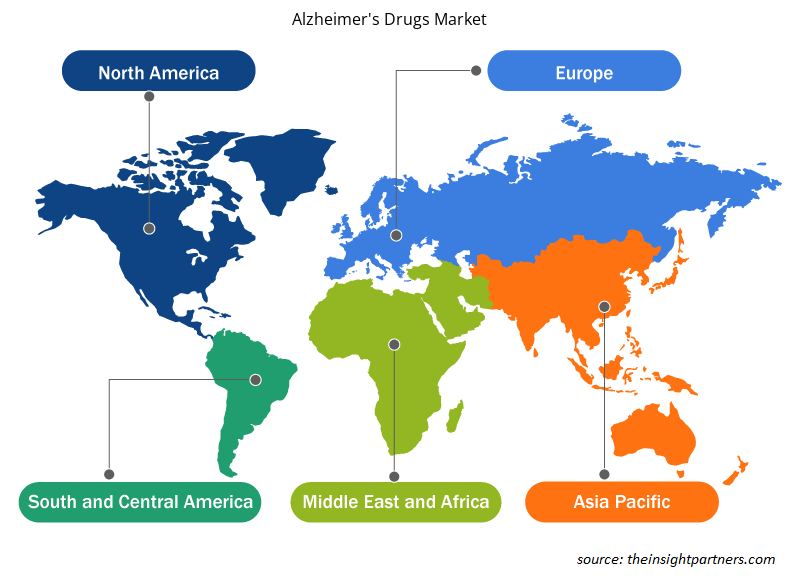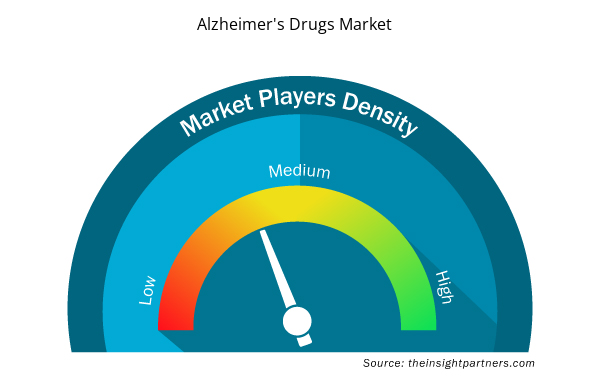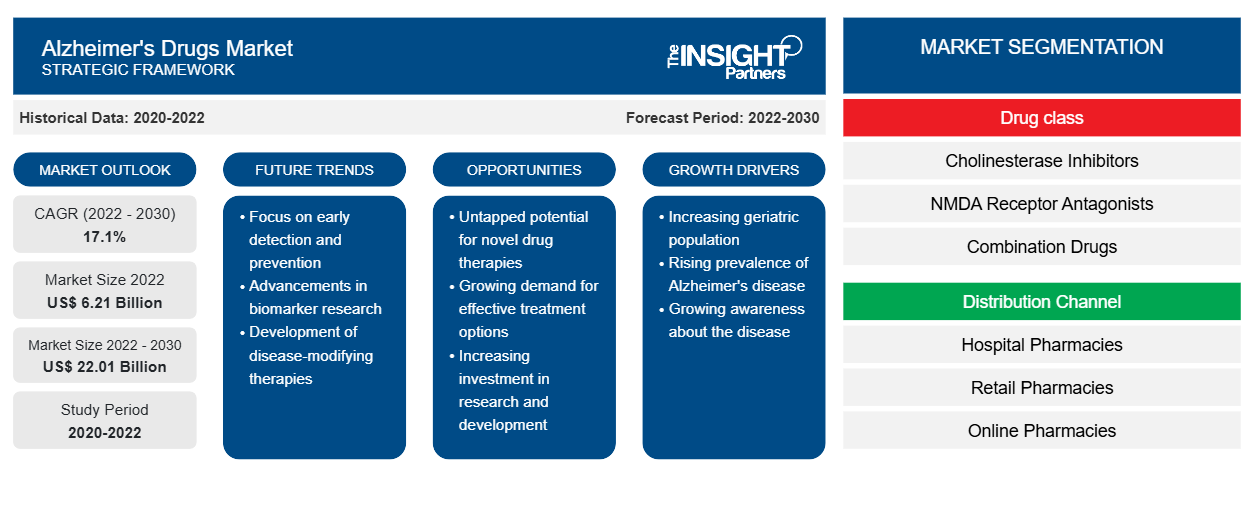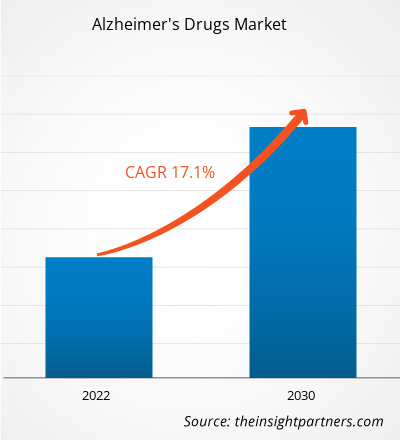[調査レポート] アルツハイマー病治療薬市場は、2022年の62億1,000万米ドルから2030年には220億1,000万米ドルに成長すると予測されており、2022年から2030年の間に17.1%のCAGRを記録すると推定されています。
市場洞察とアナリストの見解:
アルツハイマー病(AD)は、ニューロンの進行性死によって引き起こされる神経疾患です。症状は徐々に始まり、認知症につながる可能性があります。この病気は完全に治すことはできませんが、一時的に症状を緩和し、病気の進行を遅らせることができる薬があります。特に高齢者層におけるADの有病率の高さと、この病気の診断法と治療法を導入するための製薬業界の研究開発活動の増加は、アルツハイマー病治療薬市場の成長を牽引する主な要因です。しかし、薬の副作用と厳格な規制環境が市場の進歩を妨げています。さらに、ADの個別化治療と精密医療への注目の高まりにより、今後数年間でアルツハイマー病治療薬市場に新たなトレンドがもたらされると予想されています。
成長の原動力と制約:
ADおよび関連する認知症の症例の増加により、アルツハイマー病治療薬の市場規模が拡大しています。アルツハイマー病は世界中で最も一般的な認知症で、全症例の60~70%を占めています。これは進行性の神経変性疾患であり、年月とともに徐々に悪化し、高齢者層でより一般的です。2022年10月に発表された世界保健機関(WHO)の報告書によると、60歳以上の世界人口は2030年までに14億人に増加し、2050年までに21億人に達すると予想されています。この老年人口の増加により、疾病負担が増加し、今後数年間で関連する医療治療の需要が高まると予想されています。
さらに、アルツハイマー病に対する意識の高まり、診断率の向上、新しい治療法の開発への投資の増加が、市場の成長要因となっています。アルツハイマー病協会が2021年に発表したレポートによると、同協会は2020年にアルツハイマー病と認知症の研究を進めるために6,300万米ドルを投資しました。
しかし、潜在的な副作用はアルツハイマー病治療薬市場の進展に重大な影響を及ぼします。アセチルコリンエステラーゼ阻害剤(AChEI)とNMDA受容体拮抗薬は、ADの治療に一般的に処方される薬剤のクラスです。これらの薬剤は広く使用されており、指示どおりに使用すると一般的に安全であると考えられていますが、その使用にはいくつかの特定の副作用と懸念が伴います。AD薬に関連する最も重要な副作用は、過剰摂取または不適切に使用した場合のめまい、吐き気、下痢、腹痛です。これは大きな懸念であり、製品に対する消費者の信頼に影響を与え、潜在的に使用量の減少につながる可能性があります。2021年にScienceDirect Journalに掲載された記事によると、ADの治療に使用される薬剤の副作用を評価するために実施された研究では、AChEIに関連する心臓の有害事象と、メマンチンに関連する便秘、下痢、嘔吐、腹痛などの胃腸の副作用が報告されています。したがって、これらの薬の副作用はアルツハイマー病治療薬市場の妨げとなります。
要件に合わせてレポートをカスタマイズする
このレポートの一部、国レベルの分析、Excelデータパックなど、あらゆるレポートを無料でカスタマイズできます。また、スタートアップや大学向けのお得なオファーや割引もご利用いただけます。
- このレポートの主要な市場動向を入手してください。この無料サンプルには、市場動向から見積もりや予測に至るまでのデータ分析が含まれます。
レポートのセグメンテーションと範囲:
「アルツハイマー病治療薬市場分析」は、薬剤クラスと流通チャネルというセグメントを考慮して実施されました。
セグメント分析:
薬物クラスに基づいて、市場はコリンエステラーゼ阻害剤、NMDA受容体拮抗薬、併用薬、およびパイプライン薬に分類されます。コリンエステラーゼ阻害剤セグメントは、2022年に最大のアルツハイマー病治療薬市場シェアを占めました。パイプライン薬セグメントは、2022年から2030年の間に最高のCAGRを記録すると予測されています。コリンエステラーゼ阻害剤セグメントは、ドネペジル、ガランタミン、およびリバスチグミンにさらに分類されます。コリンエステラーゼ阻害剤は、精神科医や神経科医などの専門家によって、初期から中期のADに処方されます。これらの薬は、脳内のアセチルコリンのレベルを高めます。アセチルコリンは、神経細胞が互いに通信するのを助ける神経伝達物質です。
流通チャネルに基づいて、市場は病院薬局、小売薬局、オンライン薬局に分類されます。2022年には、病院薬局セグメントがアルツハイマー病治療薬の最大の市場シェアを占めました。オンライン薬局セグメントは、2022年から2030年の間に最高のCAGRを記録すると予想されています。
地域分析:
アルツハイマー病治療薬市場レポートの範囲には、北米、ヨーロッパ、アジア太平洋、南米および中米、中東およびアフリカが含まれます。2022年には、製薬会社による広範な研究開発活動と、この地域の高齢化人口におけるADおよび関連する認知症の蔓延により、北米が世界市場で最大のシェアを占めました。アルツハイマー病協会によると、2023年には、アメリカで600万人以上がADと診断され、65歳以上の約9人に1人(アメリカ人口の10.7%)がアルツハイマー病に罹患していました。さらに、2020年10月に疾病管理予防センター(CDC)が提供した統計によると、ADは米国の成人の死因の第6位です。さらに、米国全土での医療サービスへの支出の増加により、AD治療薬の需要が高まり、この地域のアルツハイマー病治療薬市場の成長に有利に働いています。
アルツハイマー病治療薬市場レポートの範囲
業界の発展と将来の機会:
アルツハイマー病治療薬市場の予測は、この市場の関係者が成長戦略を計画するのに役立ちます。世界のアルツハイマー病治療薬市場で活動している主要企業が行っている取り組みをいくつか以下に示します。
- エーザイ株式会社とバイオジェン社は2024年1月、共同開発品「LEQEMBI」の中国での販売が承認されたと発表しました。これは、ADに伴う軽度認知障害(MCI)および軽度AD認知症の治療薬として開発されたヒト化抗可溶性凝集アミロイドβ(Aβ)モノクローナル抗体です。
- 2023年5月、大塚製薬株式会社とルンドベックLLCは、共同開発中のブレクスピプラゾール含有REXULTIの追加新薬承認申請(sNDA)が、アルツハイマー病および認知症における神経精神症状の治療薬として米国食品医薬品局(FDA)の承認を取得したと発表しました。
- 2023年5月、イーライリリー社は、アルツハイマー病治療薬ドナネマブの第3相試験であるTRAILBLAZER-ALZ 2で良好な結果が出たと発表しました。この研究によると、ドナネマブは、初期症状のあるアルツハイマー病患者の認知機能と機能の低下を大幅に遅らせました。
- 2022 年 9 月、Corium, Inc. は米国でドネペジル経皮吸収システムである ADLARITY を発売しました。これは、AD 患者の軽度、中等度、または重度の認知症の治療を目的とした処方薬です。この経皮吸収システムは、皮膚を通して一定量のドネペジルを送達し、胃腸への副作用がない、初めてかつ唯一の週 1 回パッチです。
競争環境と主要企業:
アルツハイマー病治療薬市場レポートで紹介されている主な企業には、ファイザー社、シーメンス ヘルスケア社、テバ製薬工業社、グラクソ・スミスクライン社、サノフィ社、ノバルティス社、アストラゼネカ社、アッヴィ社、エーザイ社、武田薬品工業株式会社などがあります。さらに、市場とそのエコシステムの全体像を把握するために、調査期間中に他の企業数社についても調査および分析が行われました。
レポートの範囲
アルツハイマー病治療薬市場の地域別分析
予測期間を通じてアルツハイマー病薬市場に影響を与える地域的な傾向と要因は、Insight Partners のアナリストによって徹底的に説明されています。このセクションでは、北米、ヨーロッパ、アジア太平洋、中東、アフリカ、南米、中米にわたるアルツハイマー病薬市場のセグメントと地理についても説明します。

- アルツハイマー病治療薬市場の地域別データを入手
アルツハイマー病治療薬市場レポートの範囲
| レポート属性 | 詳細 |
|---|---|
| 2022年の市場規模 | 62億1千万米ドル |
| 2030年までの市場規模 | 220.1億米ドル |
| 世界のCAGR(2022年 - 2030年) | 17.1% |
| 履歴データ | 2020-2022 |
| 予測期間 | 2022-2030 |
| 対象セグメント | 薬物クラス別
|
| 対象地域と国 | 北米
|
| 市場リーダーと主要企業プロフィール |
|
アルツハイマー病治療薬市場のプレーヤー密度:ビジネスダイナミクスへの影響を理解する
アルツハイマー病治療薬市場は、消費者の嗜好の変化、技術の進歩、製品の利点に対する認識の高まりなどの要因により、エンドユーザーの需要が高まり、急速に成長しています。需要が高まるにつれて、企業は提供品を拡大し、消費者のニーズを満たすために革新し、新たなトレンドを活用し、市場の成長をさらに促進しています。
市場プレーヤー密度とは、特定の市場または業界内で活動している企業または会社の分布を指します。これは、特定の市場スペースに、その市場規模または総市場価値に対してどれだけの競合相手 (市場プレーヤー) が存在するかを示します。
アルツハイマー病治療薬市場で事業を展開している主要企業は次のとおりです。
- ファイザー株式会社
- シーメンスヘルスケア株式会社
- テバ製薬株式会社
- グラクソ・スミスクライン
- サノフィ
免責事項:上記の企業は、特定の順序でランク付けされていません。

- アルツハイマー病治療薬市場のトップキープレーヤーの概要を入手
- 過去2年間の分析、基準年、CAGRによる予測(7年間)
- PEST分析とSWOT分析
- 市場規模価値/数量 - 世界、地域、国
- 業界と競争環境
- Excel データセット


- Intradermal Injection Market
- Medical and Research Grade Collagen Market
- Lyophilization Services for Biopharmaceuticals Market
- Military Rubber Tracks Market
- Dealer Management System Market
- Photo Printing Market
- Vision Guided Robotics Software Market
- Dry Eye Products Market
- Employment Screening Services Market
- Automotive Fabric Market

Report Coverage
Revenue forecast, Company Analysis, Industry landscape, Growth factors, and Trends

Segment Covered
This text is related
to segments covered.

Regional Scope
North America, Europe, Asia Pacific, Middle East & Africa, South & Central America

Country Scope
This text is related
to country scope.
よくある質問
Key factors driving the Alzheimer’s drugs market growth include the high prevalence of AD, particularly in the senior population, and growing research and development activities in the pharmaceutical industry to introduce diagnostics and therapies for the condition.
The Alzheimer’s drugs market was valued at US$ 6.21 billion in 2022.
The Alzheimer’s drugs market is expected to be valued at US$ 22.01 billion in 2030.
Alzheimer's disease (AD) is a neurological disorder caused by the progressive death of neurons. The symptoms begin gradually and can lead to dementia. Although the condition cannot be cured completely, there are medicines available that can temporarily alleviate the symptoms and slow down the progression of the disease. Drugs from the class of cholinesterase inhibitors, NMDA receptor antagonists, and combination of these two are indicated for AD.
The Alzheimer’s drugs market, by drug class, is segmented into cholinesterase inhibitors, NMDA receptor antagonists, combination drugs, and pipeline drugs. The cholinesterase inhibitors segment held a larger market share in 2022. The pipeline drugs segment is anticipated to register a higher CAGR during 2022-2030.
The Alzheimer’s drugs market majorly consists of the players such as Pfizer Inc.; Siemens Healthcare GmbH; Teva Pharmaceutical Industries Ltd.; GlaxoSmithKline plc; Sanofi; Novartis AG; AstraZeneca; AbbVie Inc.; Eisai Co., Ltd.; and Takeda Pharmaceutical Company Limited.
Trends and growth analysis reports related to Life Sciences : READ MORE..
The List of Companies - Alzheimer’s Drugs Market
- Pfizer Inc.
- Siemens Healthcare GmbH
- Teva Pharmaceutical Industries Ltd.
- GlaxoSmithKline plc
- Sanofi
- Novartis AG
- AstraZeneca
- AbbVie Inc.
- Eisai Co., Ltd.
- Takeda Pharmaceutical Company Limited
The Insight Partners performs research in 4 major stages: Data Collection & Secondary Research, Primary Research, Data Analysis and Data Triangulation & Final Review.
- Data Collection and Secondary Research:
As a market research and consulting firm operating from a decade, we have published and advised several client across the globe. First step for any study will start with an assessment of currently available data and insights from existing reports. Further, historical and current market information is collected from Investor Presentations, Annual Reports, SEC Filings, etc., and other information related to company’s performance and market positioning are gathered from Paid Databases (Factiva, Hoovers, and Reuters) and various other publications available in public domain.
Several associations trade associates, technical forums, institutes, societies and organization are accessed to gain technical as well as market related insights through their publications such as research papers, blogs and press releases related to the studies are referred to get cues about the market. Further, white papers, journals, magazines, and other news articles published in last 3 years are scrutinized and analyzed to understand the current market trends.
- Primary Research:
The primarily interview analysis comprise of data obtained from industry participants interview and answers to survey questions gathered by in-house primary team.
For primary research, interviews are conducted with industry experts/CEOs/Marketing Managers/VPs/Subject Matter Experts from both demand and supply side to get a 360-degree view of the market. The primary team conducts several interviews based on the complexity of the markets to understand the various market trends and dynamics which makes research more credible and precise.
A typical research interview fulfils the following functions:
- Provides first-hand information on the market size, market trends, growth trends, competitive landscape, and outlook
- Validates and strengthens in-house secondary research findings
- Develops the analysis team’s expertise and market understanding
Primary research involves email interactions and telephone interviews for each market, category, segment, and sub-segment across geographies. The participants who typically take part in such a process include, but are not limited to:
- Industry participants: VPs, business development managers, market intelligence managers and national sales managers
- Outside experts: Valuation experts, research analysts and key opinion leaders specializing in the electronics and semiconductor industry.
Below is the breakup of our primary respondents by company, designation, and region:

Once we receive the confirmation from primary research sources or primary respondents, we finalize the base year market estimation and forecast the data as per the macroeconomic and microeconomic factors assessed during data collection.
- Data Analysis:
Once data is validated through both secondary as well as primary respondents, we finalize the market estimations by hypothesis formulation and factor analysis at regional and country level.
- Macro-Economic Factor Analysis:
We analyse macroeconomic indicators such the gross domestic product (GDP), increase in the demand for goods and services across industries, technological advancement, regional economic growth, governmental policies, the influence of COVID-19, PEST analysis, and other aspects. This analysis aids in setting benchmarks for various nations/regions and approximating market splits. Additionally, the general trend of the aforementioned components aid in determining the market's development possibilities.
- Country Level Data:
Various factors that are especially aligned to the country are taken into account to determine the market size for a certain area and country, including the presence of vendors, such as headquarters and offices, the country's GDP, demand patterns, and industry growth. To comprehend the market dynamics for the nation, a number of growth variables, inhibitors, application areas, and current market trends are researched. The aforementioned elements aid in determining the country's overall market's growth potential.
- Company Profile:
The “Table of Contents” is formulated by listing and analyzing more than 25 - 30 companies operating in the market ecosystem across geographies. However, we profile only 10 companies as a standard practice in our syndicate reports. These 10 companies comprise leading, emerging, and regional players. Nonetheless, our analysis is not restricted to the 10 listed companies, we also analyze other companies present in the market to develop a holistic view and understand the prevailing trends. The “Company Profiles” section in the report covers key facts, business description, products & services, financial information, SWOT analysis, and key developments. The financial information presented is extracted from the annual reports and official documents of the publicly listed companies. Upon collecting the information for the sections of respective companies, we verify them via various primary sources and then compile the data in respective company profiles. The company level information helps us in deriving the base number as well as in forecasting the market size.
- Developing Base Number:
Aggregation of sales statistics (2020-2022) and macro-economic factor, and other secondary and primary research insights are utilized to arrive at base number and related market shares for 2022. The data gaps are identified in this step and relevant market data is analyzed, collected from paid primary interviews or databases. On finalizing the base year market size, forecasts are developed on the basis of macro-economic, industry and market growth factors and company level analysis.
- Data Triangulation and Final Review:
The market findings and base year market size calculations are validated from supply as well as demand side. Demand side validations are based on macro-economic factor analysis and benchmarks for respective regions and countries. In case of supply side validations, revenues of major companies are estimated (in case not available) based on industry benchmark, approximate number of employees, product portfolio, and primary interviews revenues are gathered. Further revenue from target product/service segment is assessed to avoid overshooting of market statistics. In case of heavy deviations between supply and demand side values, all thes steps are repeated to achieve synchronization.
We follow an iterative model, wherein we share our research findings with Subject Matter Experts (SME’s) and Key Opinion Leaders (KOLs) until consensus view of the market is not formulated – this model negates any drastic deviation in the opinions of experts. Only validated and universally acceptable research findings are quoted in our reports.
We have important check points that we use to validate our research findings – which we call – data triangulation, where we validate the information, we generate from secondary sources with primary interviews and then we re-validate with our internal data bases and Subject matter experts. This comprehensive model enables us to deliver high quality, reliable data in shortest possible time.


 このレポートの無料サンプルを入手する
このレポートの無料サンプルを入手する